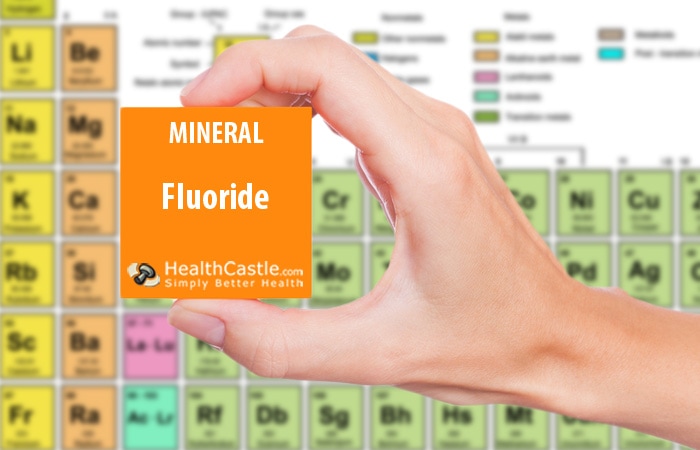
Written By: Carolyn Berry, RD
Title: Registered Dietitian
Alumni: University of British Columbia
Last Updated on:

Fluoride is a trace mineral consumed most abundantly in drinking water.
Table of Contents
The Dietary Reference Intakes (DRI) for fluoride are shown below:
| Age Group | Recommended Dietary Allowance (RDA) per Day1 | Tolerable Upper Intake Level (UL) per Day2 |
| Adults | ||
| 19 years and up | 4 mg male 3 mg female | 10 mg |
| Kids and Youth | ||
| 1 to 3 years | 0.7 mg | 1.3 mg |
| 4 to 8 years | 1 mg | 2.2 mg |
| 9 to 13 years | 2 mg | 10 mg |
| 14 to 18 years | 3 mg | 10 mg |
| Special Considerations | ||
| Pregnant women 14 years and up | 3 mg | 10 mg |
| Lactating women 14 years and up | 3 mg | 10 mg |

Fluoride occurs naturally in the body as calcium fluoride. Calcium fluoride is mostly found in the bones and teeth. During the development of the baby and permanent teeth, fluoride combines with calcium and phosphorus to form fluorapatite, making teeth resistant to cavities and decay3. Fluoride also stimulates new bone growth and is being studied for treatment of osteoporosis4.
Fluoride deficiency is rare, resulting in dental caries as the main issue. Inadequate fluoride intake may also be associated with lower bone density.
Consuming too much fluoride causes a condition called dental fluorosis, where the enamel becomes porous and the teeth become stained and pitted. Mild fluorosis causes white lines or streaks on the teeth but has no effect on tooth function. More severe fluorosis may cause tooth pain that affects chewing as well as significant discoloration of teeth.
Fluoride is found in most water, soil, plants, and animals. Most foods have very low concentrations of fluoride (usually well below 0.05 mg/100 g food). The best sources of fluoride are water (not bottled), tea, and seafood. Natural sodium fluoride is found in the ocean, so most seafood contains fluoride. We also get exposed to fluoride through dental products, like mouthwash and toothpaste.
The addition of fluoride to our tap water has been shown to be the most effective and inexpensive way to offer fluoride protection to the largest number of people. Research has shown decreased rates of tooth decay and cavities, especially in children, in places where fluoride is added to the water.
There is no established % daily value for fluoride in either the United States or Canada.
HealthCastle has strict sourcing guidelines. We reference peer-reviewed studies, scientific journals and associations. We only use quality, credible sources to ensure content accuracy and integrity.
Alumni: University of British Columbia – Carolyn Berry is a Vancouver-based Registered Dietitian, self-proclaimed foodie, marathon runner, and owner of Berry Nourished. Carolyn works in a variety of areas including clinical nutrition, outpatient counselling at Medisys Preventive Health Clinic, as a nutrition tour leader with Save-On-Foods, and in the media, including segments on CBC Television, CKNW and Spice Radio. Through informative and practical nutrition advice and her food-first approach to health, Carolyn fulfills her passion to empower others with knowledge about nutrition so that they can make the best decisions to improve their health. She strongly believes that food should be both healthful and delicious.
fluoride, micronutrient - minerals, minerals